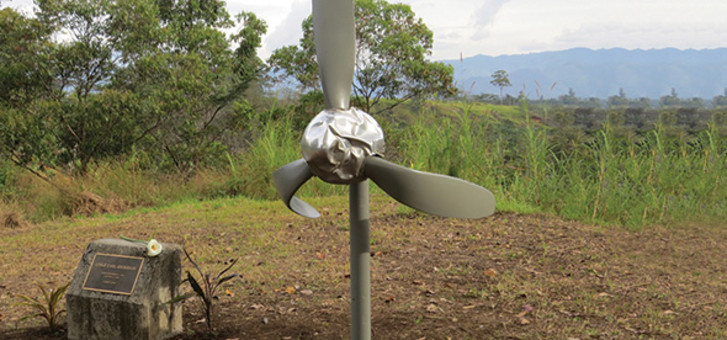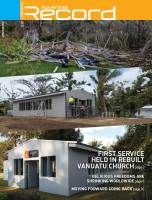From time to time I’d thought about returning to Papua New Guinea where my husband, Les Anderson, had worked with Adventist Aviation Services (AAS), but somehow the time, distance, cost and emotional energy necessary to make such a trip happen seemed more than I could manage. My assault by two raskols (criminals) early in our four-year stint and Les's death in a 2002 plane crash had taken a heavy emotional toll on me.
I'd heard about the upcoming centenary anniversary celebrations for AAS in 2014 and considered attending but wasn't sure if I was ready to open up memory's door quite so wide. After a lot of thought I decided not to go. Then I received a personal invitation from Bennett Spencer, the CEO of AAS. Halfway through reading it I burst into tears. I was shocked that emotions, long suppressed, could overflow without warning. That's when I knew that going back was something I wanted and needed to do. There was no guarantee that healing or closure would happen but I was willing to gamble on the possibility.
When Les and I first went to Ethiopia in the '60s—young, naïve and enthusiastic—we had no understanding of the reality of mission service. Going to PNG 30-plus years later, I thought I knew what to expect—the separation from family, the difficulty with communication, the dangers to health and person, church politics and interpersonal conflicts and, for me, the ever present concern for Les's safety. I knew he loved his work. He had always wanted to be a missionary and had learned to fly specifically to assist him with this work.
Three days before that fateful Friday he admitted he was tired, that he guessed he had gotten flying out of his system and was ready to go home. I wasn't surprised. He was not a shirker and if a job needed to be done he would do it. But he was carrying a heavy load.
Months after his death I was leafing through our Marriage Encounter notebooks from the '80s and found a letter Les had written to me. He wrote about flying and the possibility of dying in a plane crash, thanking me for giving him the freedom to do what he loved though it was dangerous, and acknowledging that I spent many anxious hours awaiting his return. In conclusion he said he just wanted me to know that if he died, I should remember that he was content because he had God's love and mine, and that was enough. In my head I knew this to be true—that God's love is ultimately "enough" to carry us through every circumstance. However, when lived out in real time, I saw "through a glass darkly". Our four years in Goroka were the best and worst years of my life; the highs so high I felt like I was in heaven and the lows so low I wanted to die.
I believe the Lord took me by the hand and led me step by step on my journey. He gave me an understanding travelling companion, my husband Dave Giles, who had been a friend of Les's long before the untimely deaths of our respective spouses. Dave's eldest son had also died in a plane crash so he was well acquainted with the emotions that swirled around in my heart.
But now it was the return journey—first from our home in the United States to Australia and then onwards to PNG. As we walked through the Cairns departure gate I glanced out the window and saw the Air Niugini plane sitting on the tarmac. I could scarcely breathe. I expected to have moments of panic or tears at the house, the gravesite or the hangar, but certainly not before I got to PNG. This episode surprised me because it was so unexpected and so sudden. Thankfully it was also brief.
We arrived in Goroka during a heavy shower. Everything seemed so familiar. The baggage unloading and collection were exactly the same as when we’d lived there and took just as long. The same metal gates kept back the noisy, jostling crowds. Billboards that used to advertise condoms and warn about AIDS were now plastered with cell phone ads. The market, sports field, stores along the highway, Kabiufa School—all were the same. When we drove up to the gate of our old house, we were introduced to a whole crowd of new faces. Dave, being a pastor pilot like Les, fitted right in. I didn't feel like talking so I walked inside alone, seeing Les everywhere, heavy with a sense of loss. But soon little children were running in and out, laughing and playing, and others wandered inside to visit while we ate our late meal. The painful past was engulfed in the vibrant, cheerful, noisy present, and it felt good.
I didn't go back to PNG to be a tourist, though I had many opportunities to take pictures and travel. I didn’t go back to have fun, though Bennett and others kindly arranged for us to participate in many delightful activities similar to those that had brought me great joy when I lived in Goroka. I went back to find closure. From the moment they brought Les's body back to the hangar until I left PNG, I had been in a state of shock. Everything happened so suddenly there just wasn't time to finish what I wanted to do, say what I wanted to say, see those I wanted to see before my departure. Now with this second visit AAS was giving me an opportunity to attend to some of that unfinished business.
The 12 years since my departure had compressed my longings to a single wish. More than anything else I wanted to visit Les's grave. First thing. First hour if possible. But it didn't happen that way. I was asked to delay my visit a day because a crew was fixing up the headstones and wanted everything to look nice before I saw it. I appreciated the sentiment but I could have handled the construction better than the waiting. On the next day when I did try to go, I found the graveyard fenced and the gate padlocked. I thought about becoming a raskol and climbing over the wires. Instead, I left a lily stuck in the chain and walked away heartbroken. I'd come so far and waited so long for this moment, only to be shut out. The feeling of disappointment was intense.
I share this experience not to make anyone feel bad but to recognise that often our minds fixate on things that we believe will help us move forward. Visiting Les's grave was that one thing for me. Fortunately the locked gate was not the end of the story. Later I was given a gate key to keep for the duration of my stay and was able to visit the graveyard as often as I wished. The very first time I went I found my lily leaning against Les's headstone and thanked the Lord for the kindness of the person who’d placed it there.
So what did I do in the graveyard? I studied the headstone and the smashed propeller, which I had not seen before. I thought about how grateful I was that Les had not suffered and that his body had been recovered. I thought about the individual people Les had touched during his years in PNG, about the work of AAS, about the years of my own life since I had last knelt there beside his grave. I prayed for my national friends still labouring in PNG, for the staff of AAS and the challenges they face every day, for my children and Les's family who wanted to be with me, and for the families of all the others buried in that quiet place. I asked the Lord for a faith strong enough to hold me until I could talk to Him face to face.
Sitting under the trees all alone, I sang songs of hope, longing and thanksgiving as I gazed out over the valley towards Elimbari. I stayed until my tears were spent and my heart was at peace. It was not easy to revisit the pain and loss but by doing so I found healing and closure. On my final visit, Bennett’s wife Dalena and their children helped me carry armloads of flowers to place on all the graves. Dry-eyed and hopeful, I locked the gate for the final time, so very thankful to the Lord and AAS for allowing me to return.
Altogether we spent 10 days in Goroka. Dave usually drove to the hangar with Bennett and I stayed with Dalena and the children in Kabiufa, so it was like old times. How quickly the routine returned. How familiar the stories around the supper table. How delightful the hike up the Kabiufa houseline, the visits to the market, the music at Town Church. The flight to Maimafu and Kora was beautiful, though I admit I was apprehensive about flying. The airplane seemed way too big for the short grassy strips. Maimafu is still steep and scary but I closed my eyes and saw Les preaching at the camp meeting we attended there the Sabbath before he died. The evangelistic meetings in Goroka every night, the parades Thursday and Friday morning, the well-trained Pathfinder drill team, the marching ladies bands, the flight to Kopiago where pioneer Len Barnard first worked—every day was a blessing. I found dear national friends whom I never expected to see again on this earth and it was as though we had never been apart. I made new friends among the former AAS pilots and felt incredibly blessed by the support and love they showed me during my visit.
Sabbath was the best day of all. I had seen huge crowds at meetings before but it was a profoundly moving sight for Dave. We were surrounded by a brotherhood of AAS workers and an immense family of national believers and friends. After observing the scene for a while, Dave asked, "If Les could see this crowd of believers who have come to celebrate what the Lord and AAS have done for them, do you think he would feel it was worth the sacrifice?"
A young man sang "What a Day That Will Be" and I quietly hummed a harmony part. I thought about Les, about the other loved ones we have laid to rest and longed for Jesus to come soon. Yes, on that glorious morning it will indeed be "worth it all".
Mary Lane lives in the United States with her husband Dave.






